Surveillance Research Program Bulletin–Winter 2008
Contents
Mission Statement
The Surveillance Research Program (SRP) directs the collection and analysis of data to answer key questions about cancer incidence, morbidity, mortality, and cancer-related health status in diverse regions and populations in the United States. As part of the SRP mission, the Cancer Statistics Branch (CSB) manages the Surveillance, Epidemiology, and End Results (SEER) Program, an integrated, comprehensive, multiple population-based cancer registry system authorized by the National Cancer Act of 1971.
SRP also provides leadership, through its Statistical Research and Applications Branch (SRAB), in developing statistical methodologies appropriate for analyzing trends and evaluating the impact of cancer control interventions as well as geographic, social, behavioral, genetic, and health care delivery factors on the cancer burden.
Highlights
Annual Report to the Nation on the Status of Cancer, 1975-2004
Published in November 2007, this report provides updated information on cancer incidence and trends in the United States. It represents a collaborative effort among the Centers for Disease Control and Prevention (CDC), the American Cancer Society (ACS), the National Cancer Institute (NCI), and the North American Association of Central Cancer Registries (NAACCR). Unique to this report is a comprehensive compilation of cancer information on American Indians and Alaska Natives (AI/AN). Major findings include that, for all U.S. races/ethnicities combined, there were favorable trends in incidence and mortality rates for lung and colorectal cancer in men and women and for breast cancer in women. For the AI/AN group, overall cancer rates were lower than for non-Hispanic whites from 1999–2004 for most cancers, but they were higher for cancers of the stomach, liver, cervix, kidney, and gallbladder.
Available at http://seer.cancer.gov/report_to_nation/.
Espey DK, Wu X, Swan J, Wiggins C, Jim M, Ward E, Wingo PA, Howe HL, Ries LAG, Miller BA, Jemal A, Ahmed F, Cobb N, Kaur JS, Edwards BK. Annual Report to the Nation on the Status of Cancer, 1975-2004, Featuring Cancer in American Indians and Alaska Natives. Cancer; Published online, October 15, 2007 (DOI: 10.1002/cncr. 23044); Print issue date, November 15, 2007.
IMS and NCI/SRP—A Collaborative Relationship
In 1984, NCI contracted with Information Management Services, Inc. (IMS) for support in systems design and analysis; computer programming; coordinating clinical trials; medical coding, editing, and data management; and technical documentation. What began as a 3-year contract expanded into a collaborative relationship spanning more than two decades, during which IMS extensively contributed—and continues to contribute—to major initiatives within NCI.
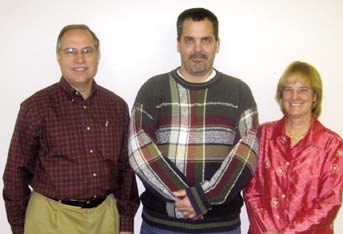 IMS’s flexibility in meeting NCI’s growing technology needs helped foster this relationship. “As NCI’s Division of Cancer Control and Population Sciences (DCCPS) expanded and computer technology changed, the support services provided by IMS shifted toward more systems development work for high-technology applications. Additional staff members were recruited to meet the growing needs of SRP in the areas of statistical and methodologic support, geographic information system (GIS) technology, andWeb development,” stated David Roney, IMS project manager. IMS’s flexibility in meeting NCI’s growing technology needs helped foster this relationship. “As NCI’s Division of Cancer Control and Population Sciences (DCCPS) expanded and computer technology changed, the support services provided by IMS shifted toward more systems development work for high-technology applications. Additional staff members were recruited to meet the growing needs of SRP in the areas of statistical and methodologic support, geographic information system (GIS) technology, andWeb development,” stated David Roney, IMS project manager.
IMS project manager Janis Beach added, “IMS brings flexibility in staff. We don’t believe in the ‘one size fits all’ concept and have adapted to the changing times, making our collaborative efforts more cost-effective and efficient. Personally, it’s been a pleasure being a part of all this.”
With more than 30 years of information technology and clinical trials experience, IMS currently provides services in analytic support, systems development, Web development, statistical methodology, data management and maintenance, computing infrastructure, and publications support. In facilitating the research efforts of the NCI community, IMS has performed key roles in methodologic research and data analysis. This has led to IMS staff members often being recognized as coauthors on publications.
A major collaborative project between IMS and SRP’s Statistical Research and Applications Branch (SRAB) led to the development of Joinpoint, a statistical software program that “has been applied worldwide by statisticians and nonstatisticians alike to model trends for time-series data such as cancer mortality and incidence counts/rates data and, more recently, to cancer survival data,” stated Ram Tiwari, Ph.D., SRAB mathematical statistician.
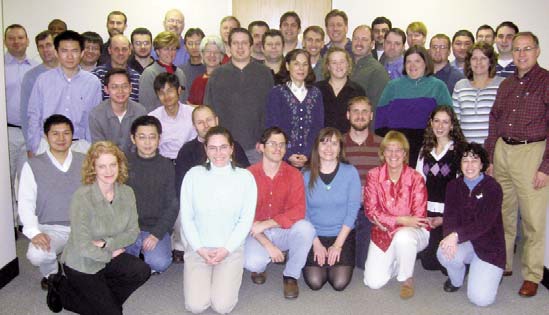 Additionally, joint efforts between IMS and SRP’s Cancer Statistics Branch (CSB) have resulted in many successful projects, including statistical software programs such as SEER*Stat and SEER*Prep. Another major project was the development of SEER*DMS, a registry management program facilitating the collection and reporting of cancer incidence data. “We have deployed SEER*DMS in four registries and expect to organize deployments in up to four more registries within the next year,” IMS project manager Dave Annett mentioned. “We credit IMS staff members for providing extensive support in quality control and software development,” added Lynn Ries, M.S., health statistician, CSB. Reflecting on the IMS and NCI/SRP relationship, Mr. Roney stated, “We hope [our relationship] continues for a long time to come. We enjoy working with NCI and SRP as shown in the high staff retention rate for IMS under our contract. In fact, of the original nine key personnel from the 1984 contract, seven are still employed and one retired.” “We definitely would like to see things continue as they have been, especially with NCI investigators, in a collaborative and adaptive fashion,” added Mr. Annett. Additionally, joint efforts between IMS and SRP’s Cancer Statistics Branch (CSB) have resulted in many successful projects, including statistical software programs such as SEER*Stat and SEER*Prep. Another major project was the development of SEER*DMS, a registry management program facilitating the collection and reporting of cancer incidence data. “We have deployed SEER*DMS in four registries and expect to organize deployments in up to four more registries within the next year,” IMS project manager Dave Annett mentioned. “We credit IMS staff members for providing extensive support in quality control and software development,” added Lynn Ries, M.S., health statistician, CSB. Reflecting on the IMS and NCI/SRP relationship, Mr. Roney stated, “We hope [our relationship] continues for a long time to come. We enjoy working with NCI and SRP as shown in the high staff retention rate for IMS under our contract. In fact, of the original nine key personnel from the 1984 contract, seven are still employed and one retired.” “We definitely would like to see things continue as they have been, especially with NCI investigators, in a collaborative and adaptive fashion,” added Mr. Annett.
Tobacco Control Workshop Features Cancer Registry Panel
On December 4, 2007, a tobacco control workshop, titled “Linking Tobacco Control Policies and Practices to Early Cancer Endpoints: Surveillance as an Agent for Change,” was held in Philadelphia, PA. Participating organizations included the American Association for Cancer Research (AACR), ACS, NCI, and CDC. Workshop sessions focused on current tobacco control surveillance systems, cancer data registries, tobacco control and health outcomes modeling, and future directions in tobacco control. Specific workshop goals included: (1) to summarize previous work relating surveillance of tobacco control policies and other interventions to outcome measures; (2) to discuss new ways to assess interventions at the state and regional level and to link them to early disease outcomes; (3) to identify gaps in tobacco control and cancer outcome surveillance, in mathematical modeling interrelating tobacco control measures and cancer outcomes, and in other barriers constraining research; and (4) to communicate the value of policy intervention research
.   
Representing NCI’s SRP, Brenda Edwards, Ph.D., Associate Director, chaired a panel on cancer registry issues related to data sources and availability for calculating rates such as incidence, mortality, survival, and years of life lost (YLL). Dr. Edwards was joined by David Stinchcomb, M.A., M.S., CSB Branch Chief, who served as a panelist for the session.
SRP Staff Attend APHA 135th Annual Meeting and Expo
SRP staff members Judith Swan, M.H.S., Antoinette Percy- Laurry, M.S.P.H., and Leyda Su Ham, D.O., M.P.H., M.B.A., attended the American Public Health Association’s (APHA) 135th Annual Meeting and Expo in Washington, DC, November 3–7, 2007. The meeting consisted of more than 900 scientific sessions, roundtables, poster sessions, institutes, and panel discussions. Its theme was “Politics, Policy, and Public Health,” and the meeting explored the relationship between the political and public health policy processes in ensuring the public’s health.
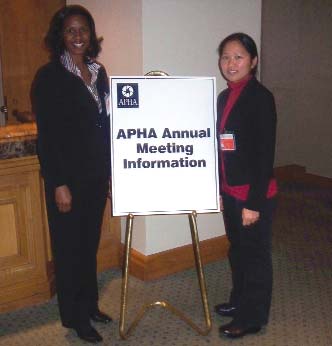 “The meeting definitely was an enriching learning experience,” acknowledged Dr. Su Ham. “I participated in one of the APHA Learning Institutes educational workshops. The workshop and the conference in general afforded me the opportunity to meet and learn from leaders in the public health community.” “The meeting definitely was an enriching learning experience,” acknowledged Dr. Su Ham. “I participated in one of the APHA Learning Institutes educational workshops. The workshop and the conference in general afforded me the opportunity to meet and learn from leaders in the public health community.”
“It was great seeing various experts in the field of public health sharing new and prominent research. However, one of my favorite highlights was to see former Surgeon General Dr. C. Everett Koop make a surprise cameo appearance in a political satire for an evening comedy show sponsored by APHA,” added Ms. Percy-Laurry.
APHA’s 136th Annual Meeting will be held in San Diego, CA, October 25–29, 2008. The theme of this meeting is “Public Health Without Borders.” For more information, visit http://www.apha.org/meetings/.
2007 CDC PHIN Conference Recap
Carol Kosary, M.A., CSB mathematical statistician, attended the fifth Annual Public Health Information Network (PHIN) Conference, held in Atlanta, GA, on August 27–29, 2007. PHIN is a CDC initiative aimed at “improving public health by enhancing research and practice through best practices related to efficient, effective, and interoperable public health information systems.” The conference offered numerous sessions to facilitate innovation, research, collaboration, and advancement in public health informatics and the National Health IT Initiative and to encourage dialogue among public health stakeholders.
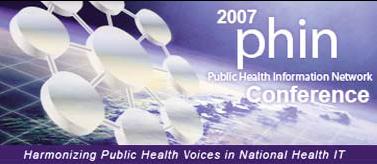 “I really enjoyed the conference and found it very interesting,” commented Ms. Kosary. “In the future, we would like to consider collaborating with CDC to expand CSB’s involvement, especially in terms of holding breakout sessions.” “I really enjoyed the conference and found it very interesting,” commented Ms. Kosary. “In the future, we would like to consider collaborating with CDC to expand CSB’s involvement, especially in terms of holding breakout sessions.”
For more information on PHIN, visit http://www.cdc.gov/ phin/index.html.
Funding Opportunities
Dissemination and Diffusion
Research Funding Administrative supplements for cancer-related surveillance research currently are available from NCI’s DCCPS. Current NCI recipients of R01, P01, P50, U01, and U19 grants related to cancer control may apply for this supplemental funding.
The goals of these supplements are:
- To fund innovative dissemination of surveillance research results to increase application of these results in policy, practice, and communities across the cancer continuum.
- To encourage surveillance researchers to develop and test ways to expand use of their data.
- To encourage researchers and program planners in other areas, such as communication and intervention research, to consider ways to use surveillance data in their research or programs.
- To encourage transdisciplinary collaborations between researchers in surveillance and other areas, such as communications and interventions.
Refer to http://cancercontrol.cancer.gov/funding_apply.html#dd to access further funding and application details.
Additional funding opportunities may be viewed at http://cancercontrol.cancer.gov/funding_apply.html.
Employment Opportunities
NCI is inviting applications for several positions within SRP, DCCPS. U.S. citizenship or permanent residency is required for Federal positions. The U.S. Department of Health and Human Services (HHS) and NIH are equal opportunity employers. For each position, send a letter summarizing your experience and interests and a complete CV, including the names of three references, by electronic mail to the listed contact.
Position in Spatial Statistics
SRP has an active program of research in the statistical analysis of spatial and temporal patterns of cancer, spatial data visualization, and GIS (http://gis.cancer.gov/). Opportunities exist for collaboration and leadership in the areas of spatial statistics and geographically related analysis throughout NCI and with other NIH Institutes, other Federal agencies, and the extramural research community.
Requirements: A Ph.D. in biostatistics or a related field and experience in spatial statistical methods applications and research, with an emphasis on model-based methods. Experience in one or more of the following areas also is desirable: disease-rate mapping, geovisualization, GIS, and cancer registry data analysis.
Contact: Eric J. (Rocky) Feuer, Ph.D., Chief, Statistical Research and Applications Branch, rf41u@nih.gov.
Positions in Mathematical Statistics and Biostatistics
NCI has several positions available within the SEER Program. Each position includes responsibility for initiating and managing collaborative analyses with scientists from NCI and other Institutes, agencies, and academic centers. Current openings include Senior Mathematical Statistician (minimum 4 years’ postdoctoral experience) and Biostatistician (minimum 2 years’ postdoctoral experience). There also are positions available for experienced statisticians with a master’s degree.
Contact: Judith Swan, M.H.S., Surveillance Research Program, js60y@nih.gov.
Quantitative Epidemiologist/Social Scientist
SRP invites applications for a quantitative epidemiologist/ social scientist with a focus on social correlates of cancer. The position focuses on utilization of novel measures of health disparities, examination of individual versus ecologic measures of socioeconomic status, and/or geospatial analysis.
Requirements: A graduate degree and several years’ experience related to statistics and health disparities.
Contact: Judith Swan, M.H.S., Surveillance Research Program, js60y@nih.gov.
Statistician in Population Genetics
SRP invites applications for a statistician with expertise in population genetics. SRP is expanding its program in the area of statistical genetics, including genome-wide association studies and the examination of gene-environment interactions. The position focuses on methodologic research and statistical genetics to address methodologic questions in cancer epidemiology.
Requirements: A doctoral degree in biostatistics or statistics and several years of postdoctoral experience related to developing methods in population genetics.
Contact: Ram Tiwari, Ph.D., Statistical Research and Applications Branch, tiwarir@mail.nih.gov.
Cancer Surveillance Research Positions
SRP invites applications from qualified candidates in the area of cancer surveillance research. The positions range from summer-only to 1-year appointments. Successful candidates will come into contact with scientists and public health professionals representing a variety of research disciplines. Mechanisms include the Cancer Research Training Award (CRTA) and the Intergovernmental Personnel Act (IPA) sabbatical position.
Contact: Ram Tiwari, Ph.D., Statistical Research and Applications Branch, tiwarir@mail.nih.gov.
For further information on all positions, see:
http://surveillance.cancer.gov/jobs
http://seer.cancer.gov/
http://srab.cancer.gov/
Meetings and Training Opportunities
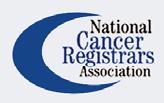 2008 NCRA Annual Conference 2008 NCRA Annual Conference
The National Cancer Registrars Association (NCRA) 34th annual educational conference will be held April 28–May 1, 2008, in Minneapolis, MN. This year’s theme is “Twin Goals: Educating and Advocating for Cancer Registrars.” For more information on this meeting, visit http://www.ncra-usa.org/conference/.
 2008 NAACCR Annual Conference 2008 NAACCR Annual Conference
The 2008 annual conference of the North American Association of Central Cancer Registries (NAACCR) will take place June 10–12, 2008, in Denver, CO, at the Grand Hyatt Hotel. Further information may be found on the NAACCR Web site at http://www.naaccr.org.
2008 SER Annual Meeting

The 41st Annual Meeting of the Society for Epidemiologic Research (SER) is scheduled for June 24–27, 2008, in Chicago, IL. For further information, visit http://www.epiresearch.org.
2008 SEER Workshop
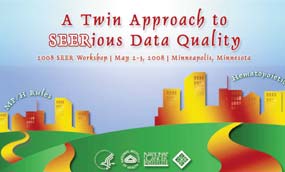 NCI’s SEER Program is sponsoring a workshop focused on data collection related to leukemias, lymphomas, and head and neck cases. The workshop will take place May 2–3, 2008, in Minneapolis, MN, at the Hilton Minneapolis. Discussion topics will include anatomy, diagnostic confirmation, primary site determination, multiple primary determination, histology coding, staging, and treatment. NCI’s SEER Program is sponsoring a workshop focused on data collection related to leukemias, lymphomas, and head and neck cases. The workshop will take place May 2–3, 2008, in Minneapolis, MN, at the Hilton Minneapolis. Discussion topics will include anatomy, diagnostic confirmation, primary site determination, multiple primary determination, histology coding, staging, and treatment.
For further information, including registration deadline, see http://www.blsmeetings.net/seer2008workshop/index.htm.
Additional cancer registrar training resources can be found at http://seer.cancer.gov/training/.
SRP Staff News
Awards
SRP Receives NIH Group Merit Awards
In November 2007, SRP was honored with several 2007 NIH Group Merit Awards.
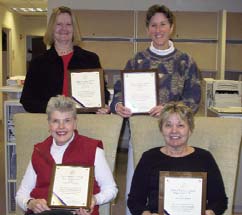 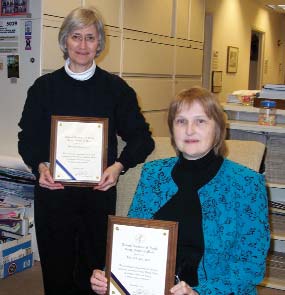 Elizabeth Flagg, Amy Garson, Terri Harshman, and Judith Swan were recognized with a
Group Award for "exemplary responsiveness and
maintenance of program
infrastructure during a time
of shrinking budgets and
expanding technologies." Elizabeth Flagg, Amy Garson, Terri Harshman, and Judith Swan were recognized with a
Group Award for "exemplary responsiveness and
maintenance of program
infrastructure during a time
of shrinking budgets and
expanding technologies."
Brenda Edwards, Ph.D., and Lynn
Ries, M.S., along with other NCI
scientists, received a Group Award for
a "landmark compendium and the
first systematic assessment in the
United States of multiple cancer risk
among 2 million cancer survivors."
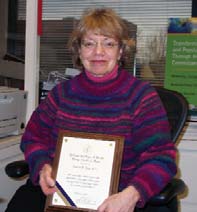 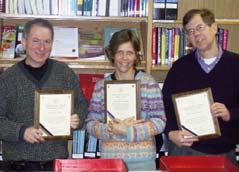 Marsha E. Reichman, Ph.D., and
fellow bioinformatics integration/implementation team members
were honored with a Group Award
recognizing the team for "leadership
in improving efforts to integrate
bioinformatics programs and to
better manage NCI's investments
in bioinformatics." Marsha E. Reichman, Ph.D., and
fellow bioinformatics integration/implementation team members
were honored with a Group Award
recognizing the team for "leadership
in improving efforts to integrate
bioinformatics programs and to
better manage NCI's investments
in bioinformatics."
In SRAB, Eric Feuer, Ph.D., Angela
Mariotto, Ph.D., and William
Davis, Ph.D., received a Group
Award for "conceptualizing and
implementing a program of
studies on the economic burden of
cancer and the cost-effectiveness
of cancer control." Other group
members included Martin Brown,
Ph.D., Joan Warren, Ph.D., and K. Robin Yabroff, Ph.D.
David Stinchcomb Receives NIH Individual Award
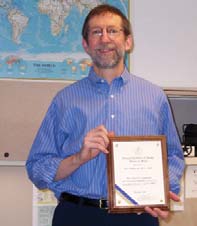 David Stinchcomb, M.A., M.S., in
his role as geographer and health
statistician, was awarded a 2007 NIH
Merit Award for his leadership in
facilitating research in the geospatial
field to support cancer surveillance
efforts at NCI. David Stinchcomb, M.A., M.S., in
his role as geographer and health
statistician, was awarded a 2007 NIH
Merit Award for his leadership in
facilitating research in the geospatial
field to support cancer surveillance
efforts at NCI.
As a lead scientist in the area of
cancer surveillance geography,
Mr. Stinchcomb's many contributions include developing the
mapping functionality for State Cancer Profiles, leading a
project to link socioeconomic and demographic data with
SEER data and make these data available to researchers, and
exploring new methods for spatial data analysis and visualization. The award recognizes Mr. Stinchcomb's work in
developing strong collaborative relationships with researchers
in other cancer surveillance organizations such as the SEER
registries, CDC's National Program of Cancer Registries (NPCR),
and NAACCR; as well as other NIH Institutes and Federal
agencies such as the U.S. Geological Survey (USGS), National
Oceanic and Atmospheric Administration (NOAA), Health
Resources and Services Administration (HRSA), and U.S.
Food and Drug Administration (FDA).
"It was a great honor to receive this award, and it has been
a pleasure to work with the many other talented and
dedicated scientists, researchers, and planners at NCI and
elsewhere to develop new ways of applying geographic
data and methods to cancer control efforts."
Marsha Reichman Steps Down as Acting CSB
Branch Chief
 Marsha E. Reichman, Ph.D., has stepped down as Acting Chief of
SRP's Cancer Statistics Branch (CSB).
Dr. Reichman "implemented a number
of exciting initiatives, and followed
up on others that awaited action,"
stated Brenda Edwards, Ph.D., associate
director, SRP. Dr. Reichman will
continue her work as Surveillance
Research Coordinator, including her
heavy involvement in developing and deploying the SEER
registry data management system (SEER*DMS); in the SEER
Residual Tissue Repository; and in research concerning
cancer-related health disparities, cancer survival, and
biospecimen studies. She also will continue her work with
the National Coordinating Council for Cancer Surveillance
(NCCCS), NAACCR committees, the steering committee for
the SEER/National Longitudinal Mortality Study (NLMS),
and the caBIG™ Population Sciences Special Interest Group." Marsha E. Reichman, Ph.D., has stepped down as Acting Chief of
SRP's Cancer Statistics Branch (CSB).
Dr. Reichman "implemented a number
of exciting initiatives, and followed
up on others that awaited action,"
stated Brenda Edwards, Ph.D., associate
director, SRP. Dr. Reichman will
continue her work as Surveillance
Research Coordinator, including her
heavy involvement in developing and deploying the SEER
registry data management system (SEER*DMS); in the SEER
Residual Tissue Repository; and in research concerning
cancer-related health disparities, cancer survival, and
biospecimen studies. She also will continue her work with
the National Coordinating Council for Cancer Surveillance
(NCCCS), NAACCR committees, the steering committee for
the SEER/National Longitudinal Mortality Study (NLMS),
and the caBIG™ Population Sciences Special Interest Group."
We have all been very impressed with Marsha's contributions to CSB and expect her interest and leadership in its
activities to continue, notably coordinating future visioning
of the SEER registry surveillance system and extramural
surveillance research based on the SEER infrastructure,"
commented Dr. Edwards.
Dave Stinchcomb Appointed CSB Branch Chief
 David Stinchcomb, M.A., M.S., has
been named Chief, CSB. Since joining SRP 3 years ago, Mr. Stinchcomb
provided extensive leadership in
various cancer surveillance projects. In
particular, he served as the scientific
coordinator and technical lead for the
nationally recognized State Cancer
Profiles interactive Web site; as senior
surveillance expert on geocoding
technology and information systems; and as a DCCPS expert
on issues involving geography, population estimates, and
socioeconomic data for SEER and other scientific databases. David Stinchcomb, M.A., M.S., has
been named Chief, CSB. Since joining SRP 3 years ago, Mr. Stinchcomb
provided extensive leadership in
various cancer surveillance projects. In
particular, he served as the scientific
coordinator and technical lead for the
nationally recognized State Cancer
Profiles interactive Web site; as senior
surveillance expert on geocoding
technology and information systems; and as a DCCPS expert
on issues involving geography, population estimates, and
socioeconomic data for SEER and other scientific databases.
Mr. Stinchcomb received a master's degree in computer
science and a second master's degree in geography, with
emphasis on medical and population geography. Before
coming to NCI, Mr. Stinchcomb held several senior
management positions in software development for such
computer industry giants as Compaq and Amdahl (aka
Fujitsu) and later began his career as a geographer at the
Texas Department of Health.
"We are delighted to have Dave," stated Dr. Edwards. "In
his short tenure, he has already demonstrated his impressive leadership, teamwork, and management skills. In fact,
his outstanding programmatic and transagency leadership
of research in GIS earned him the NIH Merit Award in
2007 and the prestigious Environmental Systems Research
Institute (ESRI) Vision Award, with colleague Linda
Pickle, Ph.D., in 2006."
Kathy Cronin Celebrates 10-Year Anniversary
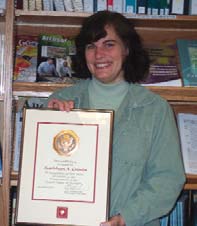 In September 2007, Kathy Cronin, Ph.D., M.P.H., celebrated 10 years of
service at SRAB. Dr. Cronin began
her career at NCI in 1995 in the
Biometry Branch of the Division of
Cancer Prevention and Control
(DCPC), after completing her doctoral
degree in operations research with a
concentration in applied probability
and statistics at Cornell University. In September 2007, Kathy Cronin, Ph.D., M.P.H., celebrated 10 years of
service at SRAB. Dr. Cronin began
her career at NCI in 1995 in the
Biometry Branch of the Division of
Cancer Prevention and Control
(DCPC), after completing her doctoral
degree in operations research with a
concentration in applied probability
and statistics at Cornell University.
"I started as a cancer prevention fellow in the statistics
group in DCPC, before we became DCCPS. I liked it here so
much, I never left," Dr. Cronin recalled.
During her fellowship, she developed and applied statistical
methods such as Bayesian monitoring plans for chemoprevention trials, reviewed case control methodologies to
determine the efficacy of cancer screening, and evaluated
cancer incidence and mortality trends using microstimulation
methods. She also earned a Master of Public Health degree
with a concentration in epidemiology at The Johns
Hopkins Bloomberg School of Public Health.
Dr. Cronin then moved to the newly established SRAB as a
mathematical statistician, where she continues to "conduct
and support statistical research, modeling, and collaboration
related to cancer surveillance and cancer control." Her current
work focuses on understanding cancer incidence, survival,
and mortality trends and ssessing the impact of cancer control
interventions on population trends. She also is a statistical
editor for the Journal of the National Cancer Institute.
Over the past decade, Dr. Cronin's dedication has earned her
several NIH Merit Awards, as well as the NIH Director's
Award for scientific excellence and leadership. Additionally, she has authored publications in refereed journals, including
the New England Journal of Medicine, Cancer Causes & Control, and the Journal of Clinical Epidemiology.
Dr. Cronin reflected, "The 10 years went by very quickly.
When I first started, SRAB was only a small group of
three. It definitely has grown a lot since then."
Amy Garson Celebrates 20-Year Anniversary
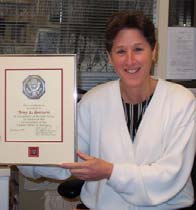 Amy Garson celebrated 20 years of service in the Federal government in 2007. Ms. Garson began her government career at CDC's Office on Smoking and Health. Ten years later, she joined the Administrative Resource Center (ARC) in NCI's DCCPS. She later moved to SRP's Office of the Associate Director, where she currently serves as a program analyst and oversees many of the Program's operations. Amy Garson celebrated 20 years of service in the Federal government in 2007. Ms. Garson began her government career at CDC's Office on Smoking and Health. Ten years later, she joined the Administrative Resource Center (ARC) in NCI's DCCPS. She later moved to SRP's Office of the Associate Director, where she currently serves as a program analyst and oversees many of the Program's operations.
"It's been gratifying to work with so many capable and dedicated individuals during my 20-year career and to be part of the DCCPS team that has done so much to lessen the burden of cancer," stated Ms. Garson.
Having been in SRP for more than 7 years, Ms. Garson's dedicated service and teamwork recently earned her a 2007 NIH Merit Award (see page 6). Among her many contributions, she "oversaw the SRP response to the ever-changing budget situation, performing in-depth assessments of the effects of ‘flat' budgets and suggesting allocation of funds to prevent problems in major programs," stated Dr. Brenda Edwards, Ph.D., associate director, SRP. "She also initiated an evaluation of the SEER Program that includes a cost analysis study and took on the role of SRP liaison with Division of Extramural Activities Support (DEAS) staff, which simplified and improved communications with this group considerably."
Ms. Garson earned her bachelor's degree in physical education with a minor in business administration from the University of Delaware and pursued graduate studies in exercise physiology at the University of Maryland.
Nailah Agyemann Named Supervisor
I n December 2007, Nailah Agyemann was named Supervisory Extramural
Support Program Specialist for NCI's DCCPS and Office of Grants Administration (OGA). She brings nearly two decades of extramural and intramural experience at several NCI offices, including the Epidemiology and Genetics Research Program (EGRP), Division of Cancer Biology (DCB), SRP, and the Office of Cancer Survivorship (OCS), to her new position. In her previous work, she garnered extensive experience in purchasing, working with research contracts and grants, and
workflow management. n December 2007, Nailah Agyemann was named Supervisory Extramural
Support Program Specialist for NCI's DCCPS and Office of Grants Administration (OGA). She brings nearly two decades of extramural and intramural experience at several NCI offices, including the Epidemiology and Genetics Research Program (EGRP), Division of Cancer Biology (DCB), SRP, and the Office of Cancer Survivorship (OCS), to her new position. In her previous work, she garnered extensive experience in purchasing, working with research contracts and grants, and
workflow management.
In her new position, Ms. Agyemann will supervise the administrative and managerial processes and ensure quality service
and an even distribution of the work load. Additionally, she
will temporarily continue her responsibilities as the DEAS
task leader for SRP and OCS, a position she has held since
DEAS first was established in October 2004.
Proud to be a part of the NCI community, Ms. Agyemann
stated, "I am ecstatic and honored to have been selected as
supervisor. My overall experience at NCI has prepared me
for my current position, but it also will be challenging as I
assume a leadership role with greater authority."
Ms. Agyemann currently is pursuing an associate's degree in business management and a certificate in events, meetings, and conference planning at Montgomery
College, with plans to graduate in May 2009.
Sean Altekruse Joins SRP
 Sean Altekruse, D.V.M., M.P.H., Ph.D., joined CSB in September
2007. A Captain in the Public
Health Service (PHS), Dr. Altekruse
is a graduate of the University of
Georgia, University of South
Carolina, Virginia Tech, and the
University of Maryland. Since 1989,
he has worked as an epidemiologist
with the U.S. Department of
Agriculture (USDA), CDC, and NCI's Division of Cancer
Epidemiology and Genetics (DCEG). As a staff scientist in
DCEG, Dr. Altekruse helped to implement the NCI Human
Papillomavirus Vaccine (HPV) Trial in Costa Rica. Earlier,
he worked with epidemiologists at the American Cancer
Society to investigate the association between hair dye use
and hematopoietic cancer among women in the Cancer
Prevention Study (CPS)-II cohort. At CSB, Dr. Altekruse is
working with SEER data on cancers of young adults and
on a pilot tissue-based surveillance project. Sean Altekruse, D.V.M., M.P.H., Ph.D., joined CSB in September
2007. A Captain in the Public
Health Service (PHS), Dr. Altekruse
is a graduate of the University of
Georgia, University of South
Carolina, Virginia Tech, and the
University of Maryland. Since 1989,
he has worked as an epidemiologist
with the U.S. Department of
Agriculture (USDA), CDC, and NCI's Division of Cancer
Epidemiology and Genetics (DCEG). As a staff scientist in
DCEG, Dr. Altekruse helped to implement the NCI Human
Papillomavirus Vaccine (HPV) Trial in Costa Rica. Earlier,
he worked with epidemiologists at the American Cancer
Society to investigate the association between hair dye use
and hematopoietic cancer among women in the Cancer
Prevention Study (CPS)-II cohort. At CSB, Dr. Altekruse is
working with SEER data on cancers of young adults and
on a pilot tissue-based surveillance project.
In 2007, Dr. Altekruse received the PHS Outstanding Service
Medal and the Agriculture Secretary's Honor Award for
leadership in Agency initiatives to control Salmonella.
Further credentials include having coauthored more than
50 scientific articles and 10 book chapters regarding infectious
disease and cancer epidemiology. He and his wife live in
Kensington with their teenaged children. His interests include
volunteering with his daughter at a therapeutic riding stable
and taking martial arts classes with his son.
SRP Shows Team Spirit in Annual NIH Relay Race
 On September 20, 2007, more than 90 five-person teams participated in the 24th Annual NIH Relay Challenge. Among
them was SRP's very own Fast*Stats team. Team members
were Marie-Jo Horner, Barry Miller, Antoinette Percy-Laurry,
Dave Stinchcomb, and Leyda Su Ham. On September 20, 2007, more than 90 five-person teams participated in the 24th Annual NIH Relay Challenge. Among
them was SRP's very own Fast*Stats team. Team members
were Marie-Jo Horner, Barry Miller, Antoinette Percy-Laurry,
Dave Stinchcomb, and Leyda Su Ham.
The relay course was a 0.5-mile loop around Building 1 on
the main NIH campus, Bethesda, MD. With a team goal of"not being last," the Fast*Stats team came in at 58th place
with a total time of 18:16 minutes—only 4:22 minutes
more than the winning time and 7:01 minutes less than
the longest time.
The NIH Challenge Relay Race, first held in 1977, is
sponsored by the NIH Recreation and Welfare Association.
Members of the team with the fastest time have their
names engraved on the Allen Lewis NIH Memorial Trophy,
located at the NIH Fitness Center.
New SRP Publications
Davis WW, Soman C, Zou J. Small area prevalence estimates using two surveys. In: Proceedings of the American Statistical
Association Survey Research Methods Section, 2007:2923-30.
Ghosh K, Tiwari RC. Empirical process approach to some two-sample problems based on ranked set samples. Annals of the
Institute of Statistical Mathematics (in press).
Ghosh K, Tiwari RC. Estimating the distribution function using
k-tuple ranked set samples. J Stat Plan Inference (in press).
Ghosh K, Tiwari RC. Nonparametric and semiparametric Bayes
reliability analysis. In: Encyclopedia of statistics in quality and
reliability. West Sussex: John Wiley & Sons, Ltd. (in press).
Ghosh K, Tiwari RC, Feuer EJ, Cronin KA, Jemal A. Prediction of
U.S. cancer mortality counts using state space models. In:
Computational methods in biomedical research. Chapman &
Hall/CRC (in press).
Kim H, Yu B, Feuer EJ. Inference in segmented line regression: a
simulation study. Journal of Statistical Computation and Simulation
(in press).
Li Y, Tiwari RC, Guha S. Mixture cure survival models with
dependent censoring. Journal of the Royal Statistical Society,
Series B (Statistical Methodology) Jun 2007;69(3):285-306.
Miller BA, Chu KC, Hankey BF, Ries LAG. Cancer incidence and
mortality patterns among specific Asian and Pacific Islander
populations in the U.S. Cancer Causes Control 2007 Nov 27
[Epub ahead of print].
Parsons VL, Schenker N, Raghunathan TE, Xie D, Davis WW.
Assessment of small area estimates from a complex survey cancer
surveillance project. In: Proceedings of the 2006 American
Statistical Association, 2007:1645-47.
Raghunathan TE, Xie D, Schenker N, Parsons VL, Davis WW, Dodd
KW, Feuer EJ. Combining information from two surveys to estimate
county level prevalence rates of cancer risk factors and screening.
J Am Stat Assoc 2007;102(478):474-86.
Simonetti A, Gigli A, Capocaccia R, Mariotto A. Method to estimate
complete prevalence of cancers diagnosed at childhood age. Stat
Med (in press).
SEER Registry News
New Collaborative Staging Version 01.04.00 Released
On October 31, 2007, the Collaborative Staging Task Force
released Collaborative Staging (CS) version 01.04.00. The
new version resolves issues from previous versions,
enhances documentation to improve the quality of data
collection, and includes changes that affect most of the
schemas and some derived fields. Implementation is
required for cases diagnosed on or after January 1, 2008.
CS is a coding system for cancer staging based on tumor
characteristics that brings together the principles of the three
major staging systems used in the United States: SEER
Summary Stage 1977, Summary Stage 2000, and TNM
categories and stage groupings. Developed to provide one
consistent staging system to meet all needs, CS utilizes
components of extent of disease to describe anatomic information about the spread of cancer at the time of diagnosis.
Further details can be found at http://www.cancerstaging.org/cstage/index.html.
VA Directive Impacts Cancer Surveillance Efforts
In August 2007, the U.S. Veterans Administration (VA)
issued a directive regarding the release of information
on VA cancer patients. Provisions under the directive included: (1) veterans hospitals will cease providing
data to a cancer registry until the registry signs the
directive; (2) permission to use VA patients' personal data must be obtained from the VA's Under Secretary of
Health or by working with an agency researcher and
then obtaining permission through the hospital's ethics board; (3) patient information must be encrypted to
prevent its unauthorized reading; and (4) patient data
must be separated from information representing the population at large.
According to VA officials, the directive aims to protect veterans' privacy and patient information. It has raised concerns among cancer surveillance researchers that the accuracy
of national cancer statistics may be compromised by the withholding of VA patient data.
"In response to this new development, we are currently
conducting VA data analysis to estimate the impact of
missing cases, such as the effect on rates," commented
Nadia Howlader, M.S., CSB biostatistician.
2007 SEER Managers and PI Meeting
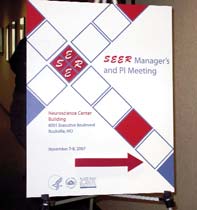 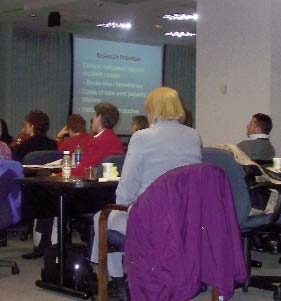 The 2007 Surveillance, Epidemiology and End Results
(SEER) Program Managers and
Principal Investigators (PI)
Meetings were held November
7–9, 2007, at the Neuroscience
Building in Rockville, MD. More
than 100 individuals from NCI's
DCCPS and SEER's 18 cancer registries participated. As in previous years, the meetings included discussions, updates, and presentations on important cancer surveillance issues and current research. In addition, several registries were recognized for their quality control efforts. The 2007 Surveillance, Epidemiology and End Results
(SEER) Program Managers and
Principal Investigators (PI)
Meetings were held November
7–9, 2007, at the Neuroscience
Building in Rockville, MD. More
than 100 individuals from NCI's
DCCPS and SEER's 18 cancer registries participated. As in previous years, the meetings included discussions, updates, and presentations on important cancer surveillance issues and current research. In addition, several registries were recognized for their quality control efforts.
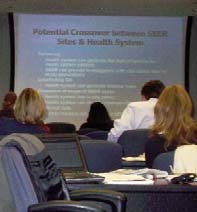 Topics addressed during the SEER Managers in-person meeting included the security of electronic data collaborative staging updates and quality improvement. At the SEER PI meeting, presentations and discussions focused on data collection, ecologic analysis using SEER data, the impact of electronic tools on cancer surveillance, biospecimen related activities, collaboration with health maintenance organizations (HMOs), drug safety
and postmarketing surveillance,
and facilitating SEER-wide studies
and collaboration between SEER
registries and outside investigators. There also was interest in
operating issues affected by budget
restrictions. Topics addressed during the SEER Managers in-person meeting included the security of electronic data collaborative staging updates and quality improvement. At the SEER PI meeting, presentations and discussions focused on data collection, ecologic analysis using SEER data, the impact of electronic tools on cancer surveillance, biospecimen related activities, collaboration with health maintenance organizations (HMOs), drug safety
and postmarketing surveillance,
and facilitating SEER-wide studies
and collaboration between SEER
registries and outside investigators. There also was interest in
operating issues affected by budget
restrictions.
SEER Registry Staff News
Jack Cunningham Retires From SEER
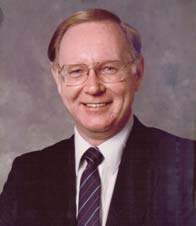 Jack Cunningham, Certified Tumor
Registrar (C.T.R.) and charter member
of the National Cancer Registrars
Association (NCRA), retired in
September 2007 after 47 years of
service in the cancer registry field.
His impressive registry career began
in 1960 as an abstractor. Just 2
years later, he became director of
the registry at the University of
Chicago Registry of Neoplastic Diseases. The registry was
also part of NCI's End Results Group (ERG), which in 1973
became NCI's SEER Program. Jack Cunningham, Certified Tumor
Registrar (C.T.R.) and charter member
of the National Cancer Registrars
Association (NCRA), retired in
September 2007 after 47 years of
service in the cancer registry field.
His impressive registry career began
in 1960 as an abstractor. Just 2
years later, he became director of
the registry at the University of
Chicago Registry of Neoplastic Diseases. The registry was
also part of NCI's End Results Group (ERG), which in 1973
became NCI's SEER Program.
In 1966, Mr. Cunningham joined the ERG field staff and
became heavily involved in cancer data coding procedures,
quality control, training personnel, and developing manuals.
He also coauthored a paper analyzing population-based data
for advanced testicular cancer. In 1994, he moved to the
Georgia Center for Cancer Statistics, where he abstracted
cases for submission to the Atlanta SEER Program Registry
until his recent retirement.
"I started soon after high school. I never believed I would be a part of the medical field and would spend so much of my
career in the hospital setting," Mr. Cunningham stated. "But, I
have enjoyed every minute of it."
In retirement, Mr. Cunningham continues his involvement with NCI as a consultant to the SEER Program.
Thomas Vaughan Steps Down as Seattle PI
 In November 2007, Thomas L.
Vaughan, M.D., M.P.H., stepped
down as the SEER PI for the Seattle
Registry after serving in that position
for more than 7 years. Steve Schwartz,
Ph.D., is assuming Dr. Vaughan's PI
responsibilities, with research interests
in testicular, oral, and cervical cancers
and the HPV vaccine. Dr. Schwartz
also is joined by Chris Li, M.D., Ph.D.,
who will serve as team co-investigator and whose interests
include breast cancer, hormones, and understanding the
relationship between risk factors and tumor characteristics. In November 2007, Thomas L.
Vaughan, M.D., M.P.H., stepped
down as the SEER PI for the Seattle
Registry after serving in that position
for more than 7 years. Steve Schwartz,
Ph.D., is assuming Dr. Vaughan's PI
responsibilities, with research interests
in testicular, oral, and cervical cancers
and the HPV vaccine. Dr. Schwartz
also is joined by Chris Li, M.D., Ph.D.,
who will serve as team co-investigator and whose interests
include breast cancer, hormones, and understanding the
relationship between risk factors and tumor characteristics.
As a SEER PI, Dr. Vaughan worked closely with NCI and
local investigators, overseeing a staff of more than 40 in
research and registry endeavors. A major milestone during his
tenure was upgrading the computing systems from a legacy
minicomputer to a network of more than a dozen firewalled
servers running a real-time failover system.
Dr. Vaughan is stepping down to devote more time to funded
research focusing on esophageal cancer and its precursors.
He is a professor in the Department of Epidemiology,
University of Washington, and Head of the Cancer
Epidemiology Program at the Division of Public Health
Sciences, Fred Hutchinson Cancer Research Center.
In describing his overall experience, Dr. Vaughan stated, "It
has been an honor working with the SEER Program, NCI,
and all of the investigators. Together they make up the best
network of cancer registries in the world."
Monique J. Doane Moves to UCSF
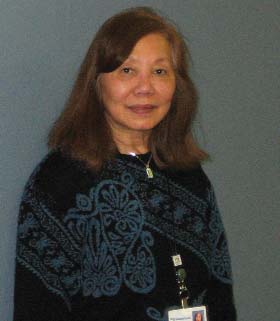 In October 2007, Monique J. Doane, M.A., R.H.I.T., C.T.R., moved to a
new Senior Registry position at the
University of California, San
Francisco (UCSF) Comprehensive
Cancer Center. Previously, Ms. Doane
worked at the Northern California
Cancer Center (NCCC), where she
was involved extensively in cancer
registry operations for the San
Francisco Bay Area/Santa Clara (Region 1 & Region 8)
registries, which are part of NCI's SEER Program. During
her 17 years at NCCC, some of Ms. Doane's responsibilities
included editing cancer data and abstracts, case-finding,
and quality control. In October 2007, Monique J. Doane, M.A., R.H.I.T., C.T.R., moved to a
new Senior Registry position at the
University of California, San
Francisco (UCSF) Comprehensive
Cancer Center. Previously, Ms. Doane
worked at the Northern California
Cancer Center (NCCC), where she
was involved extensively in cancer
registry operations for the San
Francisco Bay Area/Santa Clara (Region 1 & Region 8)
registries, which are part of NCI's SEER Program. During
her 17 years at NCCC, some of Ms. Doane's responsibilities
included editing cancer data and abstracts, case-finding,
and quality control.
With her new position at UCSF, Ms. Doane returns to the
University of California Cancer Registry, where she
worked for 10 years prior to her position at NCCC. With
more than 30 years of experience, she will be involved in
abstracting, case-finding, training staff, and quality control at
the university level. Ms. Doane also has been an active
member of the NCRA since 1981.
Leslie Bernstein Appointed New Director at
City of Hope
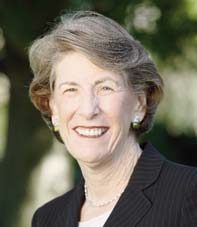 In September 2007, Leslie Bernstein,
Ph.D., was appointed Director of the
Department of Cancer Etiology in
the Division of Population Sciences
at City of Hope National Medical
Center, an NCI-designated cancer
center in Duarte, CA. She also
serves as professor and dean for
faculty development. In these roles,
Dr. Bernstein will expand cancer-related research; develop and lead a research program; and
provide career development, training, and mentoring to
scientists and students. In September 2007, Leslie Bernstein,
Ph.D., was appointed Director of the
Department of Cancer Etiology in
the Division of Population Sciences
at City of Hope National Medical
Center, an NCI-designated cancer
center in Duarte, CA. She also
serves as professor and dean for
faculty development. In these roles,
Dr. Bernstein will expand cancer-related research; develop and lead a research program; and
provide career development, training, and mentoring to
scientists and students.
Recognized as a leading international epidemiologist,
Dr. Bernstein contributed nearly 2 decades to cancer research.
Since 1988, Dr. Bernstein was involved with the NCI SEER Program as scientific director and PI of the Los Angeles County Cancer Surveillance Program, where she studied cancer incidence and monitored trends. Her major projects included the California Teachers Study, a large cohort study analyzing the effects of breast and other cancers on the more than 130,000 public school teachers and administrators comprising the cohort, and studies on esophageal adenocarcinoma and non-Hodgkin's lymphoma. Additionally, she played key roles in strategic planning and research program development within CSB.
Dr. Bernstein plans to continue her work with SEER. "During my involvement with NCI, I have seen the SEER program progress significantly. The SEER program provides extraordinary resources for research that are especially valuable in the setting of NCI's cancer agenda."
Dr. Bernstein's credentials include the 2007 Brinker
Award for Scientific Distinction by the Susan G. Komen
Foundation for the Cure for her work in clinical breast
cancer research, the 2007 American Association for Cancer
Research (AACR)-Prevent Cancer Foundation Award for
Excellence in Cancer Prevention Research, and numerous
publications in such notable journals as the New England
Journal of Medicine, Cancer Research, Biometrics, and the
Journal of the American Medical Association. She earned
her Ph.D. in biometry and master's degree in gerontology
from the University of Southern California.
New SEER Publications
Gong Z, Agalliu I, Lin DW, Stanford JL, Kristal AR. Cigarette smoking and prostate cancer-specific mortality
following diagnosis in middle-aged men. Cancer Causes Control
2008;19(1):25-31.
Nyante SJ, Gammon MD, Malone KE, Daling JR, Brinton LA.
The association between oral contraceptive use and lobular and
ductal breast cancer in young women. Int J Cancer
2008;122(4):936-41.
Peters U, Littman AJ, Kristal AR, Patterson RE, Potter JD, White
E. Vitamin E and selenium supplementation and risk of prostate
cancer in the Vitamins and lifestyle (VITAL) study cohort.
Cancer Causes Control 2008;19(1):75-87.
Setiawan VW, Monroe KR, Goodman MT, Kolonel LN, Pike MC,
Henderson BE. Alcohol consumption and endometrial cancer
risk: the multiethnic cohort. Int J Cancer 2008;122(3):634-8.
To search previous SEER publications, visit http://seer.cancer.gov/pubsearch/.
CISNET News
2007 CISNET Meeting Recap
The annual Cancer Intervention and Surveillance Modeling
Network (CISNET) meeting, held December 4–7, 2007, hosted
more than 60 individuals from various backgrounds, including
biostatisticians, educators, epidemiologists, postdoctoral
fellows, and health care
professionals. Established
in 2000, CISNET is a consortium
of investigators who
use biostatistical modeling
to better understand the
effect of cancer control
interventions on population
trends. Currently, CISNET has four NCI-sponsored teams of investigators focusing on
breast, lung, colorectal, and prostate cancers.
As in previous years, the meeting provided a multitrack
agenda, with concurrent sessions for the breast and colorectal
cancer site groups during the first 2 days and for
the lung and prostate cancer site groups in the latter 2
days. During each cancer site group meeting, participants
discussed modeling cases and scenarios, shared
information on project updates, and heard presentations on
relevant topics. Also included was a breakout session for
CISNET programmers on model calibration and result
documentation techniques.
Additionally, a general meeting for all attendees involved
sessions on model calibration, decision-analysis, and overdiagnosis
and lead time. These discussions were preceded
by an overview of CISNET’s accomplishments and future
direction provided by Eric Feuer, Ph.D., CISNET program
director and SRAB branch chief.
“Since its inception, CISNET has made numerous strides
in cancer surveillance research, particularly in employing
a comparative modeling approach,” mentioned Dr. Feuer. “ Although our investigators develop many different models,
attempts are made to address important common “base” questions—where all the models for a particular
cancer site share common inputs and produce outputs in
a common template—thus, allowing for comparison
across them. Currently, all four of CISNET’s cancer site
groups are engaging in these collaborative projects.”
“In addition to statistical modeling, CISNET has focused
on providing these models as evidence-based decision
tools to assist policymakers and cancer control planners. Examples include the Colorectal Cancer Mortality
Projections Web site (http://cisnet.cancer.gov/reports/crc_projections.html), as well as collaborations with the
U.S. Preventive Task Force to provide assistance on revising
screening guidance for breast and colorectal cancers.”
For further information about CISNET, visit http://cisnet.cancer.gov/.
New CISNET Publications
Lung Working Group
Levy DT, Bauer J, Lee H-R. The use of simulation models to
examine the effect of public policies in a dynamic social system. Am J Public Health (in press).
Levy DT, Ross H, Powell L, Bauer J, Lee HR. The role of public
policies in reducing smoking prevalence in Arizona: results from
the Arizona tobacco policy simulation model. J Public Health
Manag Pract (in press).
CISNET Report to the Agency for Healthcare
Research and Quality (AHRQ) and Centers for
Medicare & Medicaid Services (CMS)
This report is a collaborative effort between multiple CISNET
groups and U.S. government health policymakers and
provides a cost-effectiveness analysis of the DNA stool
test and other currently recommended colorectal cancer
screening strategies. It is based on research using two
microstimulation models from multiple NCI-funded CISNET
modeling groups: the MISCAN model from the Memorial
Sloan-Kettering Cancer Center and Erasmus Medical
Center, and the SimCRC model from the University of
Minnesota and Massachusetts General Hospital. Report
findings are intended to assist patients and health professionals
in making well-informed decisions and improving
the quality of health care services.
Zauber AG, Lansdorp-Vogelaar I, Wilschut J, Knudsen AB,
van Ballegooijen M, Kuntz KM. Cost-effectiveness of DNA stool
testing to screen for colorectal cancer: report to AHRQ and CMS
from the Cancer Intervention and Surveillance Modeling
Network (CISNET) for MISCAN and SimCRC models. National
Cancer Institute. 2007.
To download and view the report, visit
http://cisnet.cancer.gov/reports/cms_report.html.
Surveillance Research Program Staff
- Office of the Associate Director (OAD)
Telephone: 301-496-8506
Fax: 301-480-4077
Brenda K. Edwards, Ph.D., Associate Director
Betsy Flagg, Program Analyst
Amy Garson, Program Analyst
Terri Harshman, Program Analyst
Marsha Reichman, Ph.D., Surveillance Research Coordinator
Leyda Su Ham, D.O., M.P.H., M.B.A., Health Communications Intern
Judith Swan, M.H.S., Public Health Advisor
- Cancer Statistics Branch
Telephone: 301-496-8510
Fax:301-496-9949
David Stinchcomb, M.A.-Geo/M.S.C.S., Chief
Peggy Adamo, R.H.I.T., C.T.R., Public Health Analyst
Sean Altekruse, D.V.M., M.P.H., Ph.D., Epidemiologist
Lin Clegg, Ph.D., Mathematical Statistician
Lois Dickie, C.T.R., Public Health Analyst
Milton Eisner, Ph.D., Health Statistician
Marie-Josephe Horner, M.S.P.H., Epidemiologist
Nadia Howlader, M.S., Biostatistician
Carol Johnson, C.T.R., Public Health Analyst
Carol Kosary, M.A., Mathematical Statistician
Denise R. Lewis, Ph.D., M.P.H., Epidemiologist
Barry Miller, Dr.P.H., Epidemiologist
Antoinette Percy-Laurry, M.S.P.H., Public Health Analyst
Lynn Ries, M.S., Health Statistician
Jennifer Ruhl, R.H.I.T., C.T.R., Public Health Analyst
- Statistical Research & Applications Branch (SRAB)
Telephone: 301-435-7739
Fax: 301-480-2046
Eric J. (Rocky) Feuer, Ph.D., Chief
Kathy Cronin, Ph.D., Mathematical Statistician
Bill Davis, Ph.D., Mathematical Statistician
Rose Fredua, Program Analyst
Lan Huang, Ph.D., Mathematical Statistician
Monica Jackson, Ph.D., Mathematical Statistician
Angela Mariotto, Ph.D., Mathematical Statistician
Ram Tiwari, Ph.D., Mathematical Statistician
- Division of
Extramural
Activities Support
(DEAS)
Telephone: 301-496-8506
Fax: 301-480-2046
Nailah Agyemann,
Supervisory Extramural,
Support Program Specialist
Sue Hoffman, Extramural Support
Assistant
Ann Olumba, Extramural Support Assistant
Miquel Sample-Jubilee, Extramural Support Assistant
- Administrative Resource Center (ARC)
Telephone: 301-451-9470
Fax: 301-435-5071
Mary Kashanchi, Deputy ARC Manager
Steve Brown, Purchasing Agent
Anne Garvey, Administrative Officer
Rhonda Turner, Administrative Technician
|

